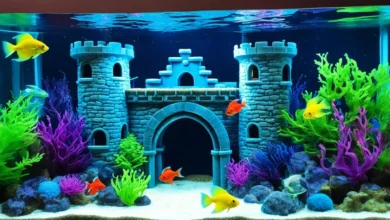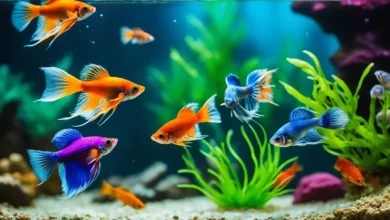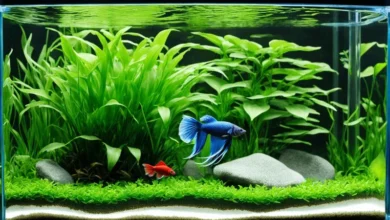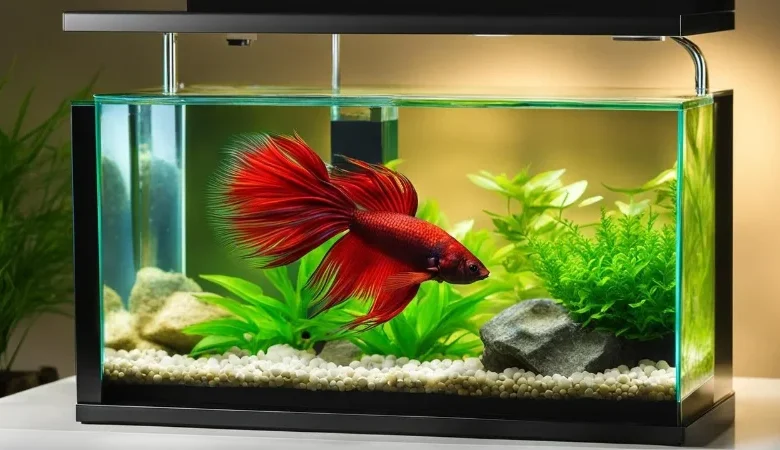
Welcome to the world of betta fish! These mesmerizing creatures, also known as Siamese fighting fish, are renowned for their vibrant colors and graceful movements. But did you know that creating a beautiful and thriving habitat for your betta fish is not just about aesthetics? It plays a crucial role in their well-being and happiness. So, if you’re a beginner looking to embark on the journey of betta fish ownership, you’re in the right place! This comprehensive guide will equip you with all the knowledge and tips you need to set up a stunning betta fish tank that will be the envy of every aquarist. Are you ready to dive in and discover the secrets to a successful betta fish tank setup?
With this guide, you’ll learn the essential steps and considerations for betta fish care, the must-have essentials for your tank, and how to design a visually stunning environment that your betta fish will love. From selecting the perfect tank size and equipment to understanding the nitrogen cycle and choosing compatible tank mates, we’ve got you covered. So, let’s begin our journey into the fascinating world of betta fish tank setup!
Betta Fish and Their Habitat Requirements
Before diving into the specifics of setting up a betta fish tank, it’s important to understand the basic requirements of betta fish and their natural habitat. Betta fish, also known as Siamese fighting fish, originate from Southeast Asia and are highly adaptive to their environment. They are known for their vibrant colors and long, flowing fins. In the wild, betta fish inhabit warm, shallow waters with plenty of plants and hiding spots. They are labyrinth fish, which means they have a special organ called a labyrinth organ that allows them to breathe atmospheric air. Understanding these habitat requirements will help us create the optimal tank setup for our betta fish.
Selecting the Perfect Tank for Your Betta Fish
When it comes to creating a comfortable and thriving environment for your betta fish, selecting the right tank size is vital. While small bowls may be popular due to their compact size, they are not suitable for long-term housing of betta fish. To provide your betta with ample space to swim and explore their habitat, a 5-gallon tank is recommended as a starting size for a single betta fish.
A larger tank offers numerous advantages for the well-being of your betta. One of the key benefits of a 5-gallon tank is that it provides your betta with more room to thrive. Betta fish are active swimmers and enjoy exploring their surroundings, and a larger tank will allow them to exhibit their natural behaviors. Additionally, a larger tank helps maintain better water quality by providing a larger volume of water, reducing the frequency of water changes.
By choosing a 5-gallon tank, you are investing in the long-term health and happiness of your betta fish. They will have ample space to thrive, swim, and display their vibrant colors. Moreover, the larger tank size will contribute to a more stable and balanced aquatic environment, reducing stress and promoting a healthier living space for your fish.
With a proper 5-gallon tank, you can create an ideal home for your betta fish, providing them with the space they need to flourish. In the next section, we will dive deeper into the equipment essentials for a thriving betta aquarium, including the right filter, lighting, and heating setup.
Equipment Essentials for a Thriving Betta Aquarium
To create a thriving betta aquarium, it’s essential to have the right equipment in place. The proper selection and use of betta fish tank equipment such as filters, lighting, and heaters are crucial for the well-being and comfort of your betta fish.
Choosing the Right Filter
When it comes to filters for your betta fish tank, it’s important to choose one that suits the specific needs of bettas. A low-flow filter is ideal as it prevents strong currents that can stress and exhaust bettas, known for their delicate fins. Opt for a filter that provides efficient mechanical and biological filtration while maintaining gentle water movement.
By using the right filter, you can ensure a clean and healthy environment for your betta fish without subjecting them to excessive water flow.
Importance of Adequate Lighting
Adequate lighting is not only essential for the appearance of your betta fish tank but also plays a vital role in the well-being of your fish. Betta fish, like all organisms, have a natural circadian rhythm that relies on light to regulate their behavior and biological processes.
Choose a lighting system that mimics natural daylight and provides a suitable spectrum of light for your aquatic plants, if you have them. Avoid intense or bright lights that may cause stress to your betta fish. Providing a consistent lighting schedule of 8-12 hours of light per day will help maintain a healthy environment for your betta.
Heating Needs for Betta Comfort
Betta fish are tropical fish and require a stable and optimal temperature range of 78-82°F (25-28°C) to thrive. A reliable betta fish tank heater is essential to maintain the proper temperature and keep your fish comfortable and healthy.
Choose a heater that is specifically designed for small aquariums and has an adjustable thermostat to regulate the temperature. It’s important to monitor and maintain a consistent temperature in your betta fish tank to prevent stress and temperature-related health issues.
Crafting a Visually Stunning Betta Fish Tank Setup
Creating a visually stunning betta fish tank setup is a rewarding endeavor that not only brings joy to the aquarist but also provides a visually stimulating and enriching environment for the betta fish. In this section, we will explore various design techniques and tips for crafting a captivating tank that showcases the natural beauty of these magnificent fish.
To start, selecting the right substrate is crucial for achieving an aesthetically pleasing tank. Choose a substrate that complements the coloration of your betta fish and creates a natural-looking environment. Gravel, sand, or specialized substrates designed for planted tanks are popular options that add visual interest to the tank.
Next, the incorporation of decorations is crucial in creating a visually appealing betta fish tank. Decorations such as caves, driftwood, and rocks not only provide hiding places for your betta fish but also add dimension and texture to the overall design. Choose decorations that are safe for your fish and complement the theme of your tank.
One of the key elements in designing a visually stunning betta fish tank is creating focal points. These focal points draw the eye and create a visual centerpiece in the tank. Consider incorporating plants with vibrant colors or unique shapes as focal points, or use larger decorations strategically placed to create visual interest.
Lastly, proper lighting is essential for showcasing the beauty of your betta fish and enhancing the overall visual appeal of the tank. Choose lighting options that provide optimal brightness and color rendition, as well as replicate natural lighting conditions. This will ensure that your betta fish and tank decor are beautifully illuminated.
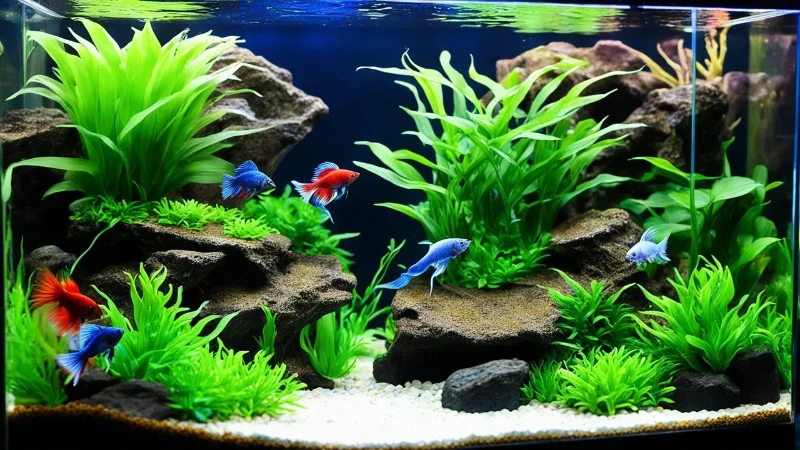
By following these design techniques and tips, beginners can create a visually stunning betta fish tank setup that not only captures the attention of onlookers but also provides a captivating habitat for their betta fish.
Designing Your Betta’s Environment with Substrate and Decorations
Creating a visually appealing and comfortable environment for your betta fish involves careful selection of substrate and decorations. The right choice of substrate and decorations not only enhances the aesthetic appeal of the tank but also contributes to the well-being of your fish. In this section, we will guide you on choosing the best substrate and decorations for your betta tank.
Best Substrate for Betta Tank
When it comes to choosing the substrate for your betta tank, there are a few options to consider. Gravel is a popular choice as it provides a natural look and allows plant roots to anchor. Another option is specialized substrates designed for planted tanks, which can facilitate plant growth and provide essential nutrients for their development. Whichever option you choose, ensure that the substrate is smooth and doesn’t have sharp edges that can harm your betta fish.
Betta Fish Tank Decorations: What to Include and Avoid
When selecting decorations for your betta tank, it’s important to consider both safety and functionality. Avoid decorations with rough or sharp edges that can injure your betta fish. Opt for decorations that provide hiding places and resting spots for your fish, such as caves, tunnels, or plants. Live plants not only add beauty to the tank but also provide natural shelter and oxygenation. Silk or soft plastic plants can also be used if live plants are not preferred. Avoid decorations with small openings or gaps where your betta fish might get stuck.
Creating a stimulating and enriching environment for your betta fish is essential for their overall well-being. Choose substrate and decorations that enhance the aesthetic appeal of your tank while prioritizing the safety and comfort of your fish.
The Role of Live Plants in a Betta Fish Tank
Live plants play a crucial role in enhancing the overall aesthetics and well-being of a betta fish tank. These beautiful aquatic plants not only add a touch of natural beauty to the environment but also offer several benefits for the health and happiness of your betta fish.
Popular Aquatic Plants for Betta Aquariums
When it comes to selecting live plants for your betta fish tank, there are various options to choose from. Here are some popular choices that are suitable for betta aquariums:
- Anubias: With its broad leaves, Anubias provides hiding spots and resting places for bettas. It is a low-maintenance plant that can thrive in a wide range of lighting conditions.
- Java Fern: Java Fern is another versatile plant that is highly compatible with betta fish. It has long, flowing leaves that create a visually appealing backdrop in the tank.
- Amazon Sword: Known for its vibrant green color and large, sword-like leaves, the Amazon Sword plant adds a sense of lushness to the aquarium. It also helps oxygenate the water and provides shelter for bettas.
These are just a few examples of the many live plants available for betta aquariums. Before adding any plants to your tank, ensure they are suitable for the specific requirements of your betta fish.
Benefits of Incorporating Live Plants
Incorporating live plants into your betta fish tank offers several benefits:
- Natural Filtration: Live plants help in naturally filtering the water by absorbing nitrates and other harmful substances. This creates a healthier and more stable environment for your betta fish.
- Oxygenation: Through the process of photosynthesis, live plants release oxygen into the water, ensuring a constant supply of fresh air for your betta fish.
- Natural Habitat: Live plants provide a natural, biodiverse habitat for bettas. They offer hiding places and territorial boundaries, making your betta feel secure and reducing stress.
The presence of live plants in a betta fish tank not only benefits the fish but also adds vibrancy and vitality to the overall aesthetic appeal. So, consider incorporating live plants into your betta tank setup for a healthier and more visually appealing environment.
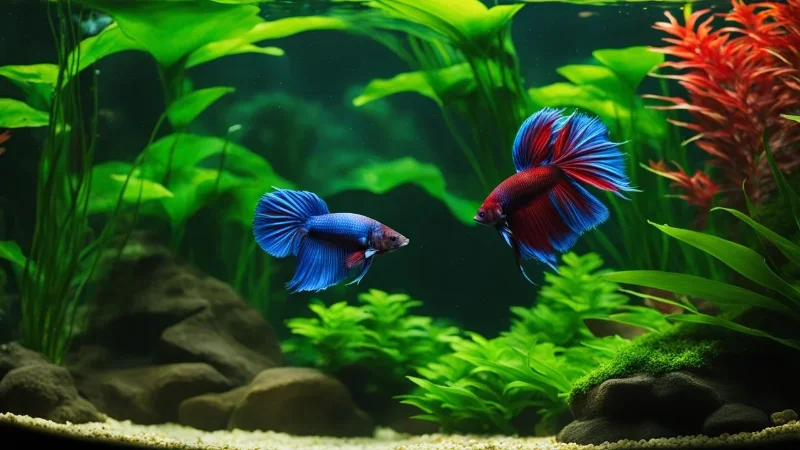
Integrating Peaceful Betta Tank Mates
While betta fish are known for their beauty, they can be territorial and aggressive towards other bettas. However, it is possible to create a peaceful community tank by choosing compatible tank mates for bettas. By introducing the right companions, you can enhance the beauty and dynamic of your betta fish tank without risking aggression or stress.
When selecting tank mates for your betta, it’s important to consider their temperament, size, and specific compatibility. Certain fish species exhibit peaceful behavior and are less likely to provoke aggression in bettas.
Here are some compatible fish species that can coexist harmoniously with bettas:
- Tetras.
- Corydoras catfish.
- Platies.
- Otocinclus catfish.
- Harlequin rasboras.
These peaceful tank mates can add diversity and movement to your betta fish tank while minimizing the risk of conflicts. However, it’s essential to introduce tank mates gradually and provide ample hiding places and territories to reduce stress.
Remember to closely monitor the behavior of your betta and tank mates during the integration process. If any signs of aggression or stress are observed, it may be necessary to separate the fish or consider alternatives.
By carefully selecting and introducing peaceful tank mates, you can create a harmonious and visually engaging community tank for your betta fish.
Understanding the Nitrogen Cycle in Betta Tanks
One of the most important aspects of maintaining a healthy and stable environment for your betta fish is understanding the nitrogen cycle in their tank. The nitrogen cycle refers to the process by which toxic ammonia is converted into less harmful substances through the action of beneficial bacteria.
To ensure the well-being of your betta fish, it is crucial to establish and maintain a proper nitrogen cycle in your tank. This cycle helps to maintain the water quality by eliminating harmful levels of ammonia and nitrite.
Steps for Cycling Your Betta Fish Tank
- Start by setting up your tank with the necessary equipment, including a filter and heater.
- Add a source of ammonia to the tank, such as fish food or ammonia solution. This will act as a food source for the beneficial bacteria.
- Monitor the levels of ammonia, nitrite, and nitrate using a water testing kit. As the nitrogen cycle progresses, you will notice a rise in ammonia levels, followed by an increase in nitrite levels.
- Once the ammonia and nitrite levels reach their peak and subsequently start to decrease, it indicates that the beneficial bacteria are actively converting these substances.
- Continue to test the water regularly and monitor the levels until both ammonia and nitrite levels reach zero. This indicates that the nitrogen cycle is complete, and the tank is ready for your betta fish.
Cycling Essentials: Testing Water Parameters
Water testing is a vital part of maintaining optimal water quality in your betta tank. By regularly testing the water parameters, you can ensure that the nitrogen cycle is functioning properly and address any potential issues before they become harmful to your fish.
When testing your betta tank water, it is essential to monitor the levels of ammonia, nitrite, nitrate, pH, and temperature. Ammonia and nitrite should be maintained at zero, while nitrate levels should be below 20 ppm (parts per million). Additionally, a pH level of 7 is considered neutral and suitable for betta fish.
By regularly testing and monitoring these water parameters, you can maintain a healthy and stable environment for your betta fish, promoting their overall well-being and longevity.
Maintaining Optimal Water Quality for Betta Health
Maintaining optimal water quality is crucial for the health and well-being of your betta fish. By closely monitoring and maintaining the water parameters in your betta tank, you can ensure a clean and stable environment that promotes the overall health of your fish.
Regular Water Testing and Changes
Regular water testing is essential to monitor the key parameters that affect your betta’s well-being. By testing for ammonia, nitrite, nitrate, pH, and temperature levels, you can identify any imbalances in the water and take appropriate actions to correct them.
Ammonia and nitrite are toxic compounds that can harm your betta fish. Regular testing allows you to detect any increases in these substances and take immediate steps to mitigate their effects. The ideal range for ammonia and nitrite levels should be zero, while nitrate levels should be kept below 20 ppm.
Monitoring the pH levels of your betta tank is also important. Betta fish thrive in slightly acidic water with a pH range between 6.5 and 7.5. Regular testing will help you maintain a stable pH level within this range, providing a comfortable environment for your fish.
Performing regular water changes is another vital aspect of maintaining water quality in your betta tank. Partial water changes of around 25% every week help remove accumulated toxins, waste, and excess nutrients that can lead to poor water quality. Make sure to use conditioned water with the same temperature as the tank to avoid shocking your betta.
When performing water changes, remember to vacuum the substrate to remove any debris that may contribute to water pollution. This will help keep your betta’s environment clean and prevent the accumulation of harmful substances.
Controlling Algae and Maintaining Clarity
Algae growth is a common issue in betta fish tanks, but it can be controlled by implementing some preventive measures. Excessive algae can not only make your tank look unsightly, but it can also compete with your betta for nutrients and oxygen.
Here are some tips for controlling algae and maintaining water clarity in your betta tank:
- Lighting: Avoid excessive light exposure as it can promote algae growth. Provide your tank with appropriate lighting periods of 8-10 hours a day, and consider using a timer to regulate the light cycle.
- Balance Nutrients: Algae thrive on excess nutrients, particularly nitrates and phosphates. Ensuring proper filtration, regular water changes, and avoiding overfeeding can minimize nutrient buildup and help prevent algae outbreaks.
- Live Plants: Incorporating live plants in your betta tank can help control algae growth by utilizing nutrients and outcompeting algae for resources. They also add beauty and provide hiding places for your betta.
- Algae Eaters: Introducing algae-eating fish or invertebrates, such as nerite snails or Amano shrimp, can help control algae in your betta tank. However, make sure they are compatible with bettas and that your tank has sufficient space and resources to support them.
By following these tips, you can effectively control algae growth and maintain the clarity of your betta fish tank.
Feeding Your Betta: Best Practices and Recommended Foods
Proper nutrition is essential for the overall health and vitality of betta fish. In this section, we will provide a comprehensive guide to feeding betta fish, including determining the right amount and types of food. We will explore the benefits of a diverse diet and discuss recommended foods for betta fish. Beginners will gain insights into feeding schedules, portion control, and how to meet the nutritional requirements of their betta fish.
Determining the Right Amount and Types of Food
When it comes to feeding your betta fish, it’s important to strike the right balance. Overfeeding can lead to health issues, while underfeeding can result in malnutrition. As a general rule, feed your betta fish small portions that they can consume within 2-3 minutes, 2-3 times a day. This will prevent overeating and maintain good water quality in the tank.
When choosing the types of food for your betta fish, opt for high-quality betta pellets or flakes that are specifically formulated for bettas. These foods are nutritionally balanced to meet the dietary needs of betta fish. Avoid feeding your bettas general fish food, as this may lack the necessary nutrients for their optimal health.
Importance of Dietary Variety
While high-quality betta pellets or flakes form the foundation of a betta fish’s diet, it’s crucial to incorporate dietary variety. Offering occasional treats such as frozen or live foods like bloodworms or brine shrimp can provide essential nutrients and simulate the betta’s natural feeding behavior.
By diversifying their diet, you can ensure your betta fish receives a wider range of nutrients, promoting overall health and enhancing their coloration. However, remember to feed these treats sparingly, as excessive consumption can lead to digestive issues.
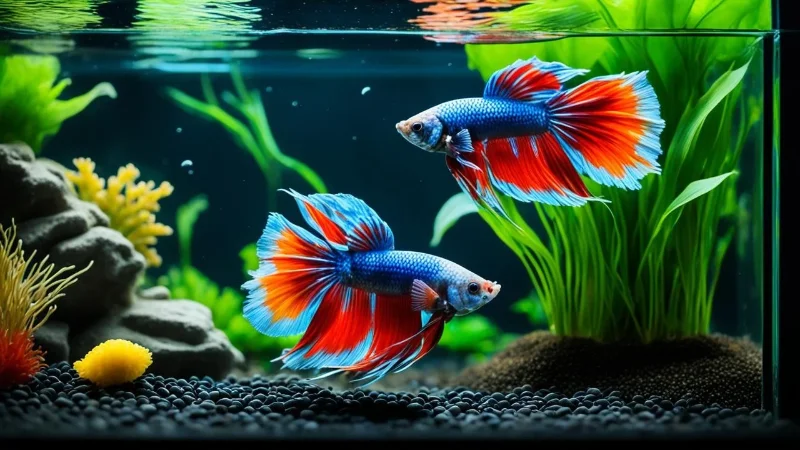
Feeding your betta fish in the right amounts and providing a varied diet will contribute to their overall well-being. By following these best practices and choosing the appropriate foods, you can help your betta fish thrive and display their vibrant colors.
Betta Fish Care and Monitoring for Well-being
While setting up and maintaining the tank is important, providing proper care and monitoring the well-being of your betta fish is equally crucial. In this section, we will discuss essential aspects of betta fish care to ensure their health and happiness.
Observing your betta fish’s behavior is a key component of their care. Pay attention to their swimming patterns, appetite, and overall activity level. Any sudden changes in behavior may indicate a potential health issue, and prompt action can prevent further complications.
Maintaining the water parameters in your betta fish tank is vital for their well-being. Regularly test the water for ammonia, nitrite, nitrate levels, pH balance, and temperature. Keeping these parameters within the appropriate range will help promote a healthy environment for your betta fish.
In addition, it is important to address common health issues that betta fish may experience. Keep an eye out for signs of diseases such as fin rot, fungal infections, or parasites. By recognizing these issues early on, you can take the necessary steps to treat them and safeguard the health of your fish.
There are several tips you can follow to promote optimal health and happiness in your betta fish. Ensure they are provided with a balanced diet that includes high-quality betta pellets and occasional treats. Keep their tank clean by performing regular water changes and maintaining proper filtration.
Remember, if you notice any persistent health issues or are unsure about your betta fish’s well-being, it is always a good idea to consult a veterinarian who specializes in fish care. They can provide expert guidance and address any concerns you may have.
By prioritizing betta fish care and monitoring their well-being, you can create a loving and nurturing environment that ensures these beautiful creatures live long and healthy lives.
Conclusion
Congratulations on reaching the end of this comprehensive guide to setting up a stunning betta fish tank! We hope you’ve gained valuable insights and feel confident in creating the perfect habitat for your betta fish. By following the advice and guidelines provided throughout this guide, you can ensure the well-being and beauty of your betta fish tank setup.
As a final tip, remember to regularly monitor the water parameters and perform routine water changes to maintain optimal water quality. This will help keep your betta fish happy and healthy. Additionally, consider adding live plants to the tank, as they not only enhance the visual appeal but also provide natural filtration and oxygenation.
When choosing tank mates for your betta, be sure to select peaceful species that can coexist harmoniously. Proper nutrition is also crucial, so provide your betta with a diverse diet that includes a variety of high-quality foods.
Lastly, enjoy the beauty and companionship of your betta fish in this well-designed and well-maintained habitat. With your dedication and knowledge, your betta fish tank will become a captivating centerpiece in your home or office.
